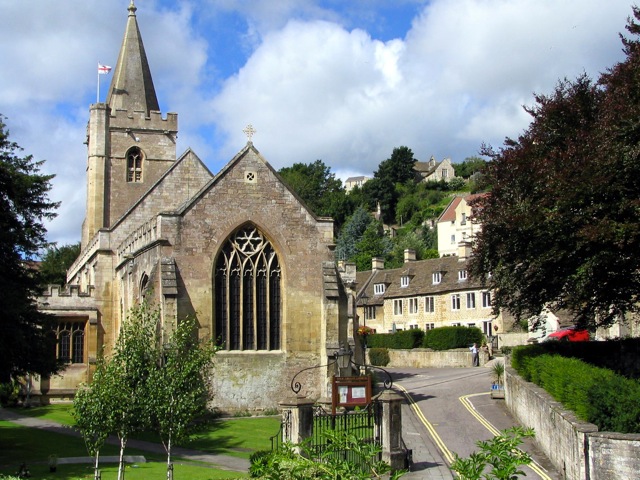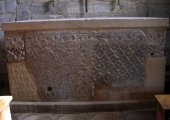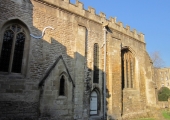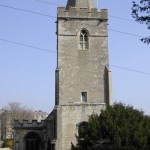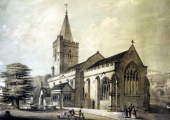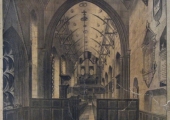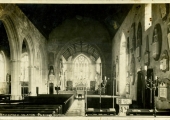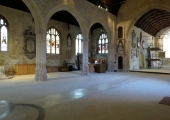.
Holy Trinity Parish Church
Church Street, Bradford on Avon
.
Holy Trinity Church was the minster and mother church of the large ancient parish of Bradford, with outlying dependent chapels at Atworth, Barley (in South Wraxall), Cumberwell, Holt, Limpley Stoke, South Wraxall and Winsley, with Westwood added later.
It was probably founded in the Saxon Period, perhaps in the early 8th century, when St Aldhelm, Abbot of Malmesbury, was reputed to have founded a monastery here. Most of what survives today is basically of the 12th century in the Norman period, seen in the fabric and romanesque-style round-headed windows, many of them now blocked. This building would have been large for its time, reflecting the importance of the estate to Shaftesbury Abbey, consisting of the present nave and chancel, except for an early 14th century eastern extension by one bay. There may have been a west tower, of which the stair turret may remain although restored, but the present tower mostly dates from the 15th century. A north aisle was formed by connecting two chapels in the 15th century, when a chapel was also added on the south side.
The 18th century saw the interior chnaged with the installation of box pews, galleries and barrel-vault plaster ceilings, making it look like long narrow non-conformist chapel.
In 1853 the architect George Gilbert Scott, in a report on the condition of the church, found that the south wall was very bad, the chancel arch had spread and part of the galleries was unsafe. Despite urging by Ewan Christian, Architect to the Ecclesiastical Commissioners, for conservation, major rebuilding work was carried out in 1864-6 by the Bath architect John Elkington Gill (1821–1874) of the firm of Manners & Gill to “restore” the internal appearance to suit Victorian taste. This resulted in stripping out many Georgian and earlier features, including the box pews, galleries, wooden pulpit and plaster ceilings, including that of the chancel dated 1632, giving seating for 637, with two pews each reserved for Kingston House (The Hall) and Chantry House. The piers of the north aisle were altered and given carved inscribed ribbons and the whole unstable south wall of the nave was rebuilt, retaining the Norman windows. The mansard nave roof that was covered with lead sheet was replaced by one of single-pitch and covered with stone tiles. An organ by William Sweetland of Bath was installed; the present one, in the north aisle was made in 1926 by Henry Willis in Liverpool.
Another major alteration to the interior, to cater to another change in taste, was carried out in 2016 by local architects Chedburn Dudley, sweeping away the 150-year-old wooden pews. At the same time the organ was restored and was slightly repositioned on its return in 2017, underfloor heating has been installed, damp-proofing carried out and a kitchen and toilet built. Some of the cost has been met by selling a painting by 16th century Flemish artist Quentin Metsys that had been given to the church in 1940 by Major Clarence and Lady Cecillie Goff of The Courts in Holt. The church is now used for functions other than religious services, even allowing for a bar.
The 2016 work disturbed the rest of several old Bradfordians in the church and churchyard, including a 6-foot Saxon, contradicting the commonly-held misbelief that people of that time were all short! The fact that the 12th century wall was found to cross Saxon graves suggests that the theory that the present building lies over the site of the original Saxon church may be correct.
See also:
- Rosemary Carr 1998. Storied Urns: Monuments in Holy Trinity Church, Bradford-on-Avon.
- Rosemary Carr 2004. The stained glass of Holy Trinity Church, Bradford on Avon, Wiltshire.
- Nikolas Pevsner 1963. Buildings of England: Wiltshire. Revised by Bridget Cherry 1975 & Julian Orbach 2021.
- Anne Willis 2001. Heard but not seen: a history of the bells of Holy Trinity, Bradford on Avon.
- Anne Willis 2015. Refurbishing Holy Trinity. Guardian Angel 77, pp. 2-6.
- Work in 2016 by Ellis & Co (new tab)
- Results of Wessex Archaeology investigations 2016 (PDF, new tab)
- Quinten Metsys -discovering a lost masterpiece (new tab)


